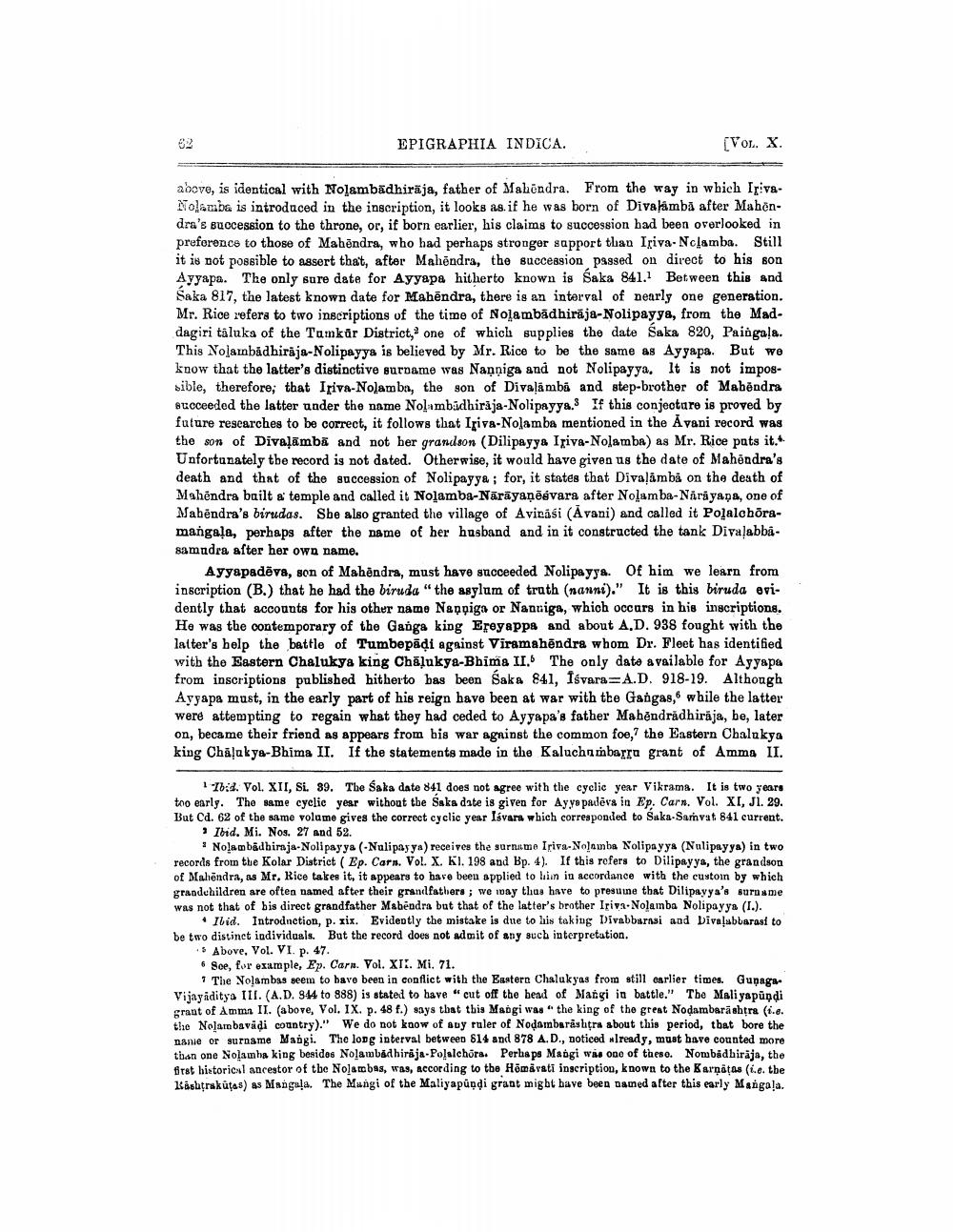________________
62
EPIGRAPHIA INDICA.
[VOL. X.
above, is identical with Nolambadhiraja, father of Mahendra. From the way in which IrivaNolamba is introduced in the inscription, it looks as. if he was born of Divakamba after Mahendra's succession to the throne, or, if born earlier, his claims to succession had been overlooked in preference to those of Mahendra, who had perhaps stronger support than Iriva-Nolamba. Still it is not possible to assert that, after Mahendra, the succession passed on direct to his son Ayyapa. The only sure date for Ayyapa hitherto known is Saka 841.1 Between this and Saka 817, the latest known date for Mahendra, there is an interval of nearly one generation. Mr. Rice refers to two inscriptions of the time of Nolambadhiraja-Nolipayya, from the Maddagiri taluka of the Tumkur District, one of which supplies the date Saka 820, Paingala. This Nolambadhiraja-Nolipayya is believed by Mr. Rice to be the same as Ayyapa. But we know that the latter's distinctive surname was Nanniga and not Nolipayya. It is not impossible, therefore; that Iriva-Nolamba, the son of Divalamba and step-brother of Mahendra succeeded the latter under the name Nolambadhiraja-Nolipayya. If this conjecture is proved by future researches to be correct, it follows that Iriva-Nolamba mentioned in the Avani record was the son of Divaļāmba and not her grandson (Dilipayya Iriva-Nolamba) as Mr. Rice pats it. Unfortunately the record is not dated. Otherwise, it would have given us the date of Mahendra's death and that of the succession of Nolipayya; for, it states that Divalamba on the death of Mahendra bailt a temple and called it Nolamba-Nārāyaṇeevara after Nolamba-Narayana, one of Mahendra's birudas. She also granted the village of Avinasi (Avani) and called it Polalchoramangala, perhaps after the name of her husband and in it constructed the tank Divalabbasamudra after her own name.
Ayyapadeva, son of Mahendra, must have succeeded Nolipayya. Of him we learn from inscription (B.) that he had the biruda "the asylum of truth (nanni)." It is this biruda evidently that accounts for his other name Nappiga or Nanniga, which occurs in his inscriptions. He was the contemporary of the Ganga king Ereyappa and about A.D. 938 fought with the latter's help the battle of Tumbepaḍi against Viramahendra whom Dr. Fleet has identified with the Eastern Chalukya king Chalukya-Bhima II. The only date available for Ayyapa from inscriptions published hitherto has been Saka 841, Isvara A.D. 918-19. Although Ayyapa must, in the early part of his reign have been at war with the Gangas," while the latter were attempting to regain what they had ceded to Ayyapa's father Mahendradhiraja, be, later on, became their friend as appears from his war against the common foe,7 the Eastern Chalukya king Chalukya-Bhima II. If the statements made in the Kaluchumbarra grant of Amma II.
1-Ibid. Vol. XII, Si. 89. The Saka date 841 does not agree with the cyclic year Vikrama. It is two years too early. The same cyclic year without the Saka date is given for Ayya padeva in Ep. Carn. Vol. XI, JI. 29. But Cd. 62 of the same volume gives the correct cyclic year Iávara which corresponded to Saka-Samvat 841 current. Ibid. Mi. Nos. 27 and 52.
Nolambadhiraja-Nolipayya (-Nulipayya) receives the surname Iriva-Nolamba Nolipayya (Nulipayya) in two records from the Kolar District (Ep. Carn. Vol. X. Kl. 198 and Bp. 4). If this refers to Dilipayya, the grandson of Mahendra, as Mr. Rice takes it, it appears to have been applied to him in accordance with the custom by which grandchildren are often named after their grandfathers; we may thus have to presume that Dilipayya's surname was not that of his direct grandfather Mahendra but that of the latter's brother Iriva-Nolamba Nolipayya (I.).
Ibid. Introduction, p. xix. Evidently the mistake is due to his taking Divabbarasi and Divalabbarasi to be two distinct individuals. But the record does not admit of any such interpretation.
Above, Vol. VI. p. 47.
6 Sce, for example, Ep. Carn. Vol. XII. Mi. 71.
The Nolambas seem to have been in conflict with the Eastern Chalukyas from still earlier times. GunagaVijayaditya III. (A.D. 344 to 888) is stated to have "cut off the head of Mangi in battle." The Maliyapuṇḍi grant of Amma II. (above, Vol. IX. p. 48 f.) says that this Mangi was "the king of the great Nodambarashtra (i.e. the Nolambavadi country)." We do not know of any ruler of Nodambarashtra about this period, that bore the nanie or surname Mangi. The long interval between 814 and 878 A.D., noticed already, must have counted more than one Nolamba king besides Nolambadhiraja-Polalchōra. Perhaps Mangi was one of these. Nombadhiraja, the first historical ancestor of the Nolambas, was, according to the Hömavati inscription, known to the Karnatas (ie. the Kashtrakutas) as Mangala. The Mangi of the Maliyapundi grant might have been named after this early Mangaļa.




